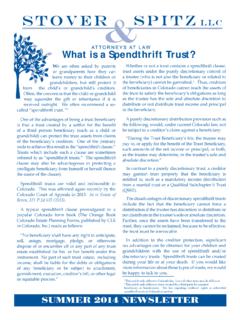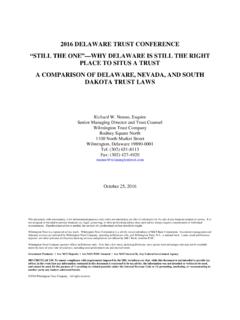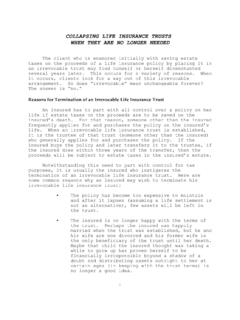Transcription of Overview of Different Types of Trusts - The Presser Law ...
1 Overview of Different Types of Trusts Living Trusts The living trust is very popular in America. A living trust helps you avoid the cost and delay of probate. You can also avoid the dangers from jointly owning assets. But a revocable living trust won t protect you from lawsuits. Though a revocable trust won t protect you, you have the comfort of knowing that you can change or revoke your living trust as often as you can revise your will. But a living trust can cause you to lose lawsuit protection? Several states have ruled that a homesteaded home transferred to a living trust loses homestead protection. Similarly, assets owned between spouses as tenants-by -the-entirety may lose creditor protection from this type of co-ownership when those same assets are instead titled to a living trust .
2 There are trade-offs between the Different ways to title assets. Without a revocable living trust , the court will distribute your assets under your will. This can be expensive, time-consuming, and cumbersome. (Probate costs can consume as much as 4% of an estate and delay estate distributions.) If you bequeath $1 million through your will, your heirs may pay $40,000 in probate costs, and wait years for their inheritances. A living trust circumvents the probate process. Your assets immediately transfer to your beneficiaries. Have the best of both worlds. Title your assets to a limited partnership (to lawsuit-proof these assets). Have your living trust (which avoids probate) own your limited partnership. When you die, your ownership in the limited partnership immediately transfers through the living trust to your heirs, and avoids probate.
3 During your lifetime your assets would be creditor-protected by the limited partnership. Irrevocable Life Insurance Trusts Life insurance is another important asset. Life insurance can have a substantial cash value or death benefit exposed to creditors. Even a term policy without cash value can be a valuable asset in that it will provide your family income and support after you are gone. But will your beneficiaries get the death benefit, or will your creditors? Life insurance can also pay your estate taxes and make funds immediately available to your survivors; thus avoiding the delay and expense of liquidating other assets. If you own a large life insurance policy, title your insurance policy to an irrevocable life insurance trust (ILIT).
4 An ILIT is specifically designed to own life insurance. As with other Trusts , the ILIT has a trustee, beneficiaries, and terms for distributions. Your ILIT would own your insurance policy. The insurance policy beneficiary would be the trust . When you die, your insurer pays the ILIT trustee, who would follow the trust instructions and distribute the proceeds to the ILIT beneficiaries. Your estate should not be the beneficiary. An ILIT can be funded or unfunded. An unfunded ILIT s life insurance premiums are not fully paid. You fund future premiums (give annual premiums to the trustee, who pays the premiums). With a funded ILIT, you transfer to the trust a fully paid insurance policy or enough income-producing assets to pay the future premiums.
5 Whether you have an unfunded or funded ILIT, your policy premiums must be directly paid from the trust . You cannot directly pay the premiums or you ll lose both the trust s tax benefits and creditor protection. The ILIT is irrevocable. It protects the policy s cash value, death proceeds, and distributions from the trust to the beneficiaries. If life insurance is not fully creditor-protected by your state laws, then an ILIT is essential for protection. The ILIT - though sometimes important for protection - can save you estate taxes. Because the ILIT owns the life insurance policy, the policy proceeds won t be included in your taxable estate, nor subject to estate taxes. Assume you are single and die with a $3 million estate and $1 million of that amount is life insurance.
6 Assume that when you die you have a $2 million death tax exemption. Your estate would then pay an estate tax on $1 million. If the estate tax is 50 %, your estate tax would be $500,000. But your ILIT would remove the $1 million life insurance proceeds from your taxable estate. Your estate would save $500,000 in estate taxes because you reduced your taxable estate to zero. The ILIT also gives you better control over policy distributions than insurance owned by you personally. When you personally own insurance, your insurance company directly pays the named beneficiaries when you die. An ILIT not only lets you control who receives the proceeds, but also how and when the policy proceeds will be distributed. For instance, you can specify that the ILIT trustee pays estate taxes and other costs (taxes due on IRAs or other retirement plans probate costs, legal fees, other debts, etc.)
7 Before the trustee distributes funds to the trust beneficiaries. Or you can direct your trustee to pay your beneficiaries over a period of months or years. You can add spendthrift, anti-alienation, discretionary distribution, and other protective provisions to protect the insurance proceeds from your beneficiaries creditors. The ILIT can also avoid court interference if a beneficiary becomes incompetent. Insurance companies won t pay life insurance proceeds to an incapacitated beneficiary. They require court instructions. The ILIT avoids this unnecessary complication. Children s Trusts Do you intend to gift money to your children? Investigate an irrevocable children s trust (ICT). It can reduce taxes as well as provide protection.
8 Property that you transfer to a children s trust cannot be seized by your creditors. It also won t be included in your taxable estate. Income from the trust would be taxed at the children s lower income tax rates. These are the reasons for the children s trust . The ICT (or Section 2503 Minor s trust ) by its terms, controls the taxation and asset protection benefits of this trust . While the trust is in effect and the beneficiary is under 21, neither the grantors nor the child s creditors can claim the trust assets. There is one disadvantage with the children s trust . When your child reaches 21, your child can demand the trust assets. Since it is an irrevocable trust , the grantor cannot withhold distributions from the trust . You cannot thus prevent your child from receiving the assets that are then owned by the trust .
9 You can only extend the trust until a later age if your child, at age 21, consents in writing. Carefully consider whether your child (ren) at that young age can properly handle the trust assets. Charitable Remainder Trusts Gifting your assets to charity may seem an extreme way to gain creditor-protection, however, our tax laws allow you to give away your property to charity, achieve protection, and use these same assets to generate income for you during your lifetime. For protection, as well as the tax advantages from gifting assets during your lifetime, the Charitable Remainder trust (CRT) can be your answer. Here s an Overview of how the CRT works. As the grantor, you select a tax-exempt charity as the beneficiary of your irrevocable trust .
10 When you create and fund the CRT, you make a charitable donation and can claim an immediate tax deduction for the value of the assets contributed to the trust . Although you have gifted the principal, you would be the income beneficiary. Over your lifetime, your trust would pay you a fixed annual income. You thus get an immediate tax deduction and future income from the donated assets. Assume that you have $200,000 in stocks that were purchased 15 years ago for $60,000. If you sold the stock to invest in treasury bonds, you would pay $21,000 in capital gains taxes on the profit (15% X $140,000 gain). If your treasury bonds are worth $200,000 when you die, your estate may then pay another $88,000 in estate taxes (although future estate taxes are uncertain).









